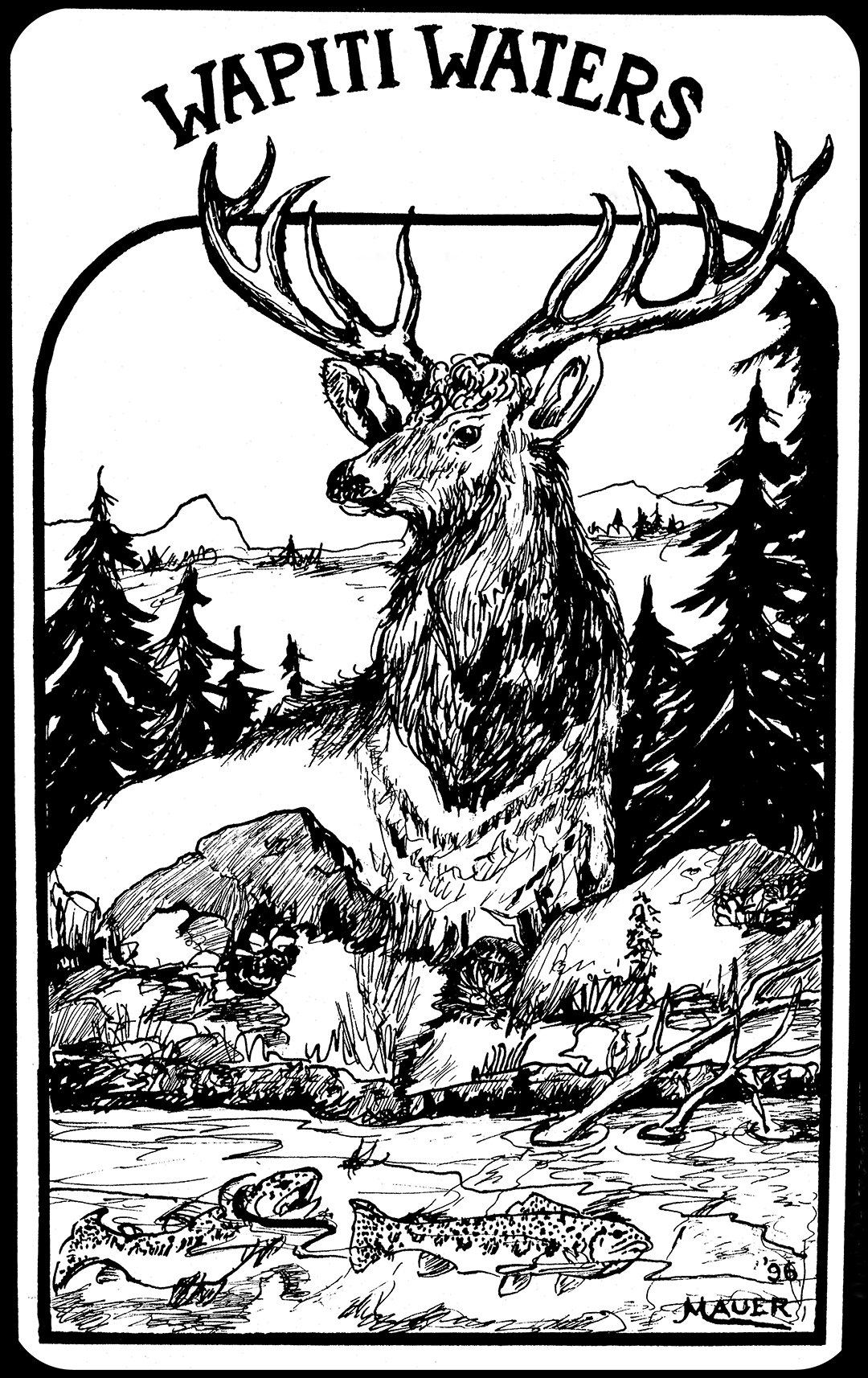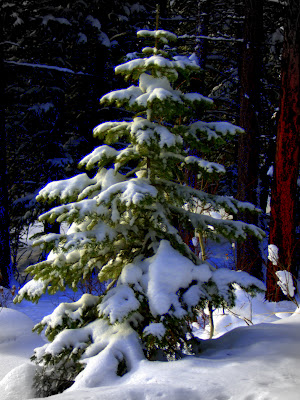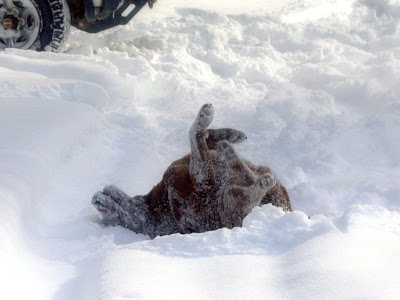by Merle Ann Loman | Jan 25, 2009 | iiii Winter/Snow
There is not much snow in the Bitterroots right now, at least not enough to find a close place to cross country ski. These photos show a desperate attempt to exercise near home and find a place to ski!
Jack and I are spending about 8 hours a day working on the business, then attend meetings, Lady Griz Basketball (my daughter plays), play music with the band, and more. Winter is busier than you might think. He ties flies, writes material, works on gear and vehicles. I do admin and web stuff. The work is necessary, but so is a mind and fitness break. For Jack’s work and for health, it is important to stay fit. We work in couple of hours of outdoor activity each day. The photos show one of our outdoor excursions with our dog, Bela.

by Merle Ann Loman | Jan 16, 2009 | hunting/fauna/flora, iiii Winter/Snow, Other
UPDATE January 26: I found that the Billings Gazette published this story January 8. It is much more complete. See it here: Buck floatsdown Yellowstone River on ice chunks By BRETT FRENCH of The Gazette Staff.
Original Wapiti Post text:

A friend sent us these photos today. Brrrr….
An unidentified photographer took these pictures in Miles City Montana where the Tongue River flows into the Yellowstone River. The buck made it to shore. The photographer saw him jump to safety when the ice jammed close to shore.
http://www.outdoordir.com/
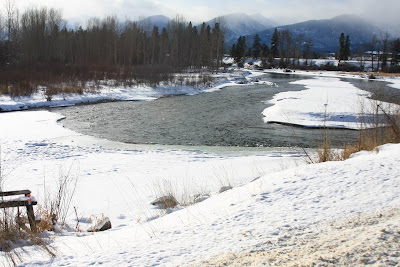
by Merle Ann Loman | Jan 3, 2009 | Bitterroot, iiii Winter/Snow

I am sharing photos of the Bitterroot valley, river and mountains in December. View the slide show or click on it to view the web album.
We had rain, then snow, then FREEZING COLD, then rain, more snow…a very unusual early winter. There is a lot of moisture, much beauty, and I need to mention the avalanche danger again. We will all be eager to get out to ski the backcountry. Please check the avalanche site for western Montana before you go. Be safe.
by Merle Ann Loman | Dec 30, 2008 | iiii Winter/Snow
I revisited a great site today. We have had new snow, now it is warming up. I wondered what information I could find about our Bitterroot snowpack. As I have said before, for fly fishing, snowpack is a huge indicator of what to expect in our upcoming season. We also want to recreate and be safe. See below and click on the hotlinks for more information.
Happy Holidays! This is Steve Karkanen at the West Central Montana Avalanche Center with the avalanche advisory for December 29th, 2008.
Please read the above link if you plan on skiing in western Montana. Danger is HIGH.
Remember the adage, be careful what you ask for? Well, we’re getting what we’ve been asking for. The problem is that it’s coming in a way that our current basal snowpack layers cannot support….
….The good news is that the new snow has been coming in gradually with a slow warm up. The weak layer near the rain crust is gaining strength over time and is adjusting quite well to each storm that slowly adds weight to it. The bad news is the cold temperatures we’ve experienced the past 2 weeks has allowed the weak granular sugary snow around the crust to persist so when we receive a storm that drops a lot of weight (several inches of snow or any amount of rain) it won’t be able to adjust fast enough to be safe. The really bad news is that the forecast is calling for a warm up with significant snowfall and wind perhaps even rain at some mountain locations this weekend.
To learn more, visit http://www.missoulaavalanche.org/events/ for classes and films showing in the Missoula area. BE SAFE!!!
Jack and I have been cross country skiing almost every day. Here is a slideshow from yesterday.
If you are going out for a back country ski, tell people where you are going and when you expect to be back. Visit this link for Weather Forecast and Avalanche Outlook in the Missoula and Bitterroot area.
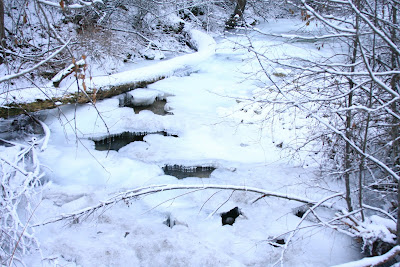
by Merle Ann Loman | Dec 23, 2008 | Conservation/benefits/organizations, iiii Winter/Snow
Click the photo for a larger view in a new window.

This is my attempt to provide a little more information about trout behavior (Part I); and ice development and anchor ice (Part II). In my research, I found only few studies, and I am pleased to reference for Part I a study that was done here in the Bitterroot.
I ran this article by Chris Clancy, our local Montana Fish, Wildlife and Parks fisheries biologist and one of the authors of the Bitterroot study. His input:
I think the take home message is that some sort of overhead cover and a variety of habitats are helpful to trout in the winter. Streams that are simplified by overgrazing or channelization lose the diversity of habitats. Deep pools are particularly important. I expect the winter movement is not really something they want to do but more likely they have to as the location they are in has changed or somehow become inadequate for their needs, so they find another. Generally in a healthy stream, the mortality during winter is much higher than summer.
Part I – Trout
Trout obviously prefer to expend as little energy as possible in the winter. In the study referenced in this section, bull trout and cutthroat trout made extensive downstream overwintering movements with declining temperature in the fall, yet for the remainder of the study (until late February), most fish remained stationary. Some fish made additional downstream movements in winter during a low-temperature period marked by anchor ice formation. Winter movement was more extensive in the mid elevation stream where frequent freezing and thawing led to variable surface ice cover and frequent supercooling. Habitat use of both species varied with availability; beaver ponds and pools with large woody debris were preferred in one stream, and pools with boulders were preferred in the other. Trout overwintered in beaver ponds in large, mixed aggregations. Both species decreased use of submerged cover following the formation of surface ice.
Their results indicate that (1) continued activity by trout during winter is common in streams with dynamic ice conditions and (2) complex mixes of habitat are needed to provide suitable fall and winter habitat for these species.
My note: It is my understanding the “complex mixes of habitat” produce more static ice conditions and are most often streams with natural vegetation and “undisturbed” i.e. not altered by man (mostly construction) or overgrazing. Open streams, where there is little or no cover and vegetation, produce more dynamic ice conditions. Other studies suggest that even though trout may be in streams with dynamic ice conditions, their preference is for more static or stable conditions – where thermal cover might help keep the surface ice from freezing and thawing.
References for Part I
THE ROLE OF STREAM ICE ON FALL AND WINTER MOVEMENTS AND HABITAT USE BY BULL TROUT AND CUTTHROAT TROUT IN MONTANA HEADWATER STREAMS, Jacober, M. J., McMahon, T. E., Thurow, R. F., Clancy, C. G., Abstract, Page 1 Click here for their paper published by the American Fisheries Society 1998
Part II – Ice
Traditionally, habitat variables have been related to stream flow distribution, structure, cover, temperature, and water quality. Winter and ice formation will influence these variables.
As winter approaches and temperatures lower, the water cools. As it reaches the freezing point, border ice begins to form along the river margins and around obstacles and skim or surface ice forms in low flow velocity areas.
In low gradient areas static ice formation occurs and surface ice is established. Due to increased resistance by the ice, water depth increases and velocities are reduced. In low gradient rivers and river reaches static ice formation occurs enabling stable conditions. Surface ice decreases the amount of light and creates cover against predation and severe hydraulic conditions allowing fish in these areas to preserve energy more efficiently.
Ice production in small, steep rivers is dominated by dynamic ice formation with potential melting and freezing throughout the entire winter. In high gradient sections, such as rapids and riffles, dynamic ice formation dominates. Dynamic ice formation starts when water temperature drops below zero degrees. Here, the water temperature becomes super cooled and tiny ice crystals form, known as frazil ice, or floating ice plates (ice that forms as small plates drifting in rapidly flowing water where it is too turbulent for pack ice to form). In locations with sufficient turbulence, frazil ice is transported towards the riverbed where it adheres and forms anchor ice. Normally, anchor ice formation develops during night and pauses during day.
Anchor ice formation can be extensive and may cover large areas. It may be distinguished between two types according to its formation process: Type I: less dense and forming on top of the substrata and Type II: Dense and forming between the substrata, filling all the small openings and spaces. During the events of anchor ice formation, flow conditions may be substantially altered. Type II anchor ice will potentially exclude important fish habitat. Fish may experience entrapment or be forced to relocate into other suitable areas, preferably surface ice covered stream margins.
In small, steep rivers, extensive growth of anchor ice may occur and lead to the formation of anchor ice dams. These anchor ice dams are normally developed in transition zones between riffle and pool sections and in locations with emergent, large boulders, and can slow further surface ice growth. High mortality of trout has been observed during the formation and breakup of anchor ice dams due to stranding, ice collapse, and physical abrasion from suspended ice particles.
References for Part II
ANCHOR ICE FORMATION AND HABITAT CHOICE OF ATLANTIC SALMON (SALMO SALAR L.)PARR IN STEEP STREAMS, Stickler, M. (M.Sc.), submitted to the Norwegian University of Science and Technology – Click here for the online paper
ICE IN THE ENVIRONMENT, Stickler, M., click here for the online paper
